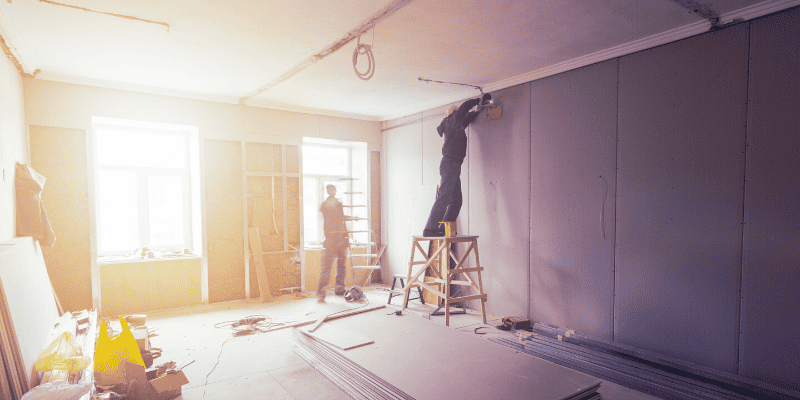Are you considering spray foam insulation for your new home or even are a current homeowner that is stuck dealing with the concerning material inside of your home? Spray foam insulation is a building material that has been used for many years, nearly 30 years by many home builders and homeowners, and placed in attics and roofs for insulation. As this building material has been continually used for decades, there has been increasingly more information and studies that have found that this popular, and seemingly un-harmful construction material may be anything but harmless when used in your home and exposed to continually each and every day. Spray foam insulation can potentially contain a hazardous mixture of chemicals that can spread into the airspace of the indoor environment and lead to health risks to those exposed to this now tainted indoor air in their homes.
The disadvantages of spray foam insulation have recently come to the forefront, with multiple studies and research collected from the Environmental Protection Agency (EPA) which found that when spray polyurethane foam is being used that the worksite or home should be restricted to people who are not wearing appropriate personal protective equipment. This safety procedure set in place is due to the generation of the chemical isocyanate which will form into a vapor and aerosol in the environment when spray foam is used and applied.
In this article, we are going to learn more about the other disadvantages of spray foam insulation and determine the best way to remediate your indoor air if your house has spray foam insulation in the attic or roof.
What is spray foam insulation
Spray foam is a chemical product that is created by two materials, isocyanates, and polyol resin, that will react when mixed with each other to expand out to about 30 to 60 times its liquid volume after it is sprayed and applied to the area in the indoor building. The capability of these two chemicals to work together to expand out is useful as a specialty packing material that forms to the shape of the product or even used in home’s for insulation. Inside of a home, spray foam can be used for a variety of things and in many different functions. Most popularly the spray foam insulation will work as an insulation and air barrier material to seal walls, floors, and ceiling cavities against air movement – including spaces around electrical outlets and light fixtures, and where walls meet windows and doors in the environment.
In addition, spray foam can also be sprayed into new homes or building structures to be applied to any open cavity such as attics, crawl spaces, and rim joists. This material is highly popular due to its ability to maintain its shape forever, as it will never lose its shape. Also, unlike other traditional insulation materials, spray foam will work to fill any cracks, gaps, or crevices in the environment.
Is spray foam insulation worth it?
Although you mainly hear about the disadvantages of spray foam insulation in a home, there are some benefits to this type of insulation material that can be considered as a major benefit or worthwhile to have in your home. It has been said that by having spray foam insulation in your home you can be creating an energy-efficient environment that is more comfortable for your family. Along with its energy-efficient capabilities in your home, it has been said to also reduce monthly energy bill costs. According to the EPA’s Energy Star Association, this type of insulation material demonstrated that it cut the monthly energy bill by up to 20%. This savings occurs because without this insulation air can leak out of seals in the home and thus create a flaw in the ventilation system.
Spray foam insulation can also help to reduce the intake of airborne irritants into the airspace of the home such as dust and pollen. When seals and cracks are covered and contained it will ultimately aid in the reduction of these outdoor pollutants from entering the home’s air. Lastly, it will help to control humidity in the home, which will, therefore, reduce the risk of mold growth.
Dangers of spray foam attic insulation
When it comes to making the decision on what kind of insulation to place in your attic there are several different preferred options that people will look into such as spray foam attic insulation. Insulation in a home is important because it helps to protect your home by keeping the heat in the indoor space during the winter months and also helps to prevent it from coming in during the summer months. Ultimately the insulation that you go with the inside of your home will affect the indoor temperature inside this environment along with having an impact on your monthly utility bill.
Spray foam insulation problems
There are several majors spray foam installation problems that have been associated with the use and application of spray foam in a home – some of these problems will vary based on how much of the spray foam is used, where it is placed, who applies the spray foam, and the conditions in this environment. Additionally, spray foam can create issues not only in the environment but also for those occupants of the home or building that are frequently exposed to the chemical composition of spray foam insulation – which has been found to be potentially hazardous to human health.
Below we are going to list the most common problems with using spray foam insulation in your home’s attic or in any area inside of your home.
Attics are the main spots in a home that are filled with unusual shapes, gaps, and spaces where air bubbles have the potential to form when you spray foam insulation. The capability of this insulation material to expand can reduce the chances that there are pockets that can reduce the R-value of the installation. If this installation is not done correctly then it can form trapped spaces for air allowing the structure to shift over time.
During the installation process if a gap is missed in your attic it can increase the potential for water intrusions to occur in the environment. This can lead to rot and insect infestations and even the potential for mold to grow in the space.
The expansive capabilities of the spray foam insulation are what gives the material its advantageous properties. However, this material can also shrink in some situations – due to aging, constant exposure to temperature changes, and the reduction of coverage overtime. If this does occur, it can lead to insulation problems that will result in a less energy-efficient home.
After spray foam is applied into a home’s attic or any other space within the indoor environment it will begin to expand and cure so that it can provide a high level of protection for the home. This insulation material will start to emit gas into the air after it is placed in the indoor environment and this gaseous odor can cause challenging physical symptoms with the exposure that include potential breathing problems and other adverse health effects.
Health issues with spray foam insulation
Spray polyurethane foam (SPF) when applied correctly and given enough to cure properly, there are minimal dangers. However, if the person that is applying this insulation material is not wearing personal protective equipment or if the foam is not applied correctly, this can create a dangerous reaction. When spray polyurethane foam is applied it will release vapors and aerosols, these vapors can be dangerous to the respiratory system, according to Tor Hoerman Law, LLC. Another health risk of spray polyurethane foam is the dust that is can create in the air – cutting and trimming the foam as it hardens will release chemicals back into the air. The chemical composition of the spray polyurethane foam consists of isocyanates – a chemical that can cause skin, eye, and lung irritation.
How long does spray foam insulation off-gas?
As we discussed previously, spray foam insulation will go through a curing process that will release two forms of toxic chemicals into the air that are used as the core components of the insulation material. In addition to the off-gassing volatile organic compounds, the uncured chemical dust will also be an issue in the environment. During the installation process of the spray foam, it is recommended that all occupants be removed from the tainted environment or the building. The only construction workers onside should be the spray foam installers that are wearing protective equipment.
After the installation job is completed the homeowners and occupants should still avoid this environment for days following the installation. The EPA standards say that under conditions where the chemicals fully react that individuals should stay out of this environment for at least 24 hours, maybe up to 72 hours to avoid certain health issues from spray foam insulation fumes in the air.
Air purifier for spray foam insulation fumes
The spray foam insulation chemical fumes and odors can spread throughout the environment and taint the entire space for those occupants. Many people will find that the spray foam insulation just down-right stinks! What can be done to remove these odors and most importantly those toxic off-gassed chemicals from the air that may become toxic to a person’s health? The one best solution that most people have found to be effective is the use of an air purifier for noxious and toxic odor and chemical neutralization.
The EnviroKlenz Air Purifier is a great solution for removing VOCs from your home or building to help both safely and effectively mitigate these airborne chemicals. This portable air purifier contains a patented earth mineral technology that effectively works to capture, contain, and neutralize noxious and toxic odors and chemicals from the air through the use of an EnviroKlenz Air Cartridge – the 1st stage in the EnviroKlenz air purifier filtration system. The second-stage filtration process in the EnviroKlenz Air Purifier is a hospital-grade HEPA filter for fine particulate removal larger than 0.3 microns in size at a 99.99 percent efficiency. Thus, this broad-spectrum pollutant control and removal technology can be an excellent choice for combating spray foam insulation vapors and odors in a home.

Air System
Mobile Air System
✓ Patented earth mineral technology works to attack VOCs and break them down on a compound level
✓ No chemicals or masking agents
✓ Will not release any chemicals back into your environment
✓ Safer and faster at removing VOC’s than traditional carbon filters and PECO air purifiers
Article Sources:
- United States Environmental Protection Agency (EPA): Potential Chemical Exposures From Spray Polyurethane Foam (link)
- Energy Star: Seal and Insulate Your Home for Comfort and Savings (link)
- Tor Hoerman Law, LLC: Spray Foam Insulation Lawsuit Alleges Chemicals Pose Deadly Health Risks (link)
EnviroKlenz® Medical Disclaimer:
“Any information that is provided on this website is not for the use by any commercial or personal entity without expressed written consent of the blog author. The material and statements illustrated within this blog are not intended to diagnose, treat, cure, or prevent any diseases or medical conditions. Nor does the author in any way guarantee or validate the validity, totality, or efficacy of any claims and will therefore not be held responsible for the content of any claims. Always consult your medical physician for any specific medical advice or recommendations.”








